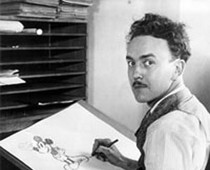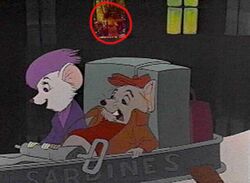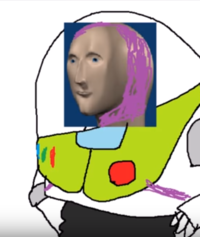Disney
The Walt Disney Company (commonly referred to as The Galactic Empire) is a very, very, very, very wealthy corporation founded by Walt and Roy Disney in 1923. The company is most commonly associated with talking rodents; big, black balls on your head; young royal females that every little girl wants to imitate; a slightly overrated amusement park; and being evil, though that last thing is becoming quite cliché.
History
1923–28: The Early Years
Brothers Walt and Roy Disney began their careers as animators making flip-books in their uncle's garage, occasionally receiving a penny or two from passerby. In 1923, Walt created Alice's Wonderland, a twelve minute short film consisting of six minutes of unique footage. The plot circled around a young girl named Alice who dreams about living in a magical cartoon world, creating a seemingly upbeat story. In the end, however, she falls off a cliff and dies. The film landed Walt and Roy a job producing animated comedies for Magaret J. Winkler, after which Walt created a new character, Oswald the Lucky Rabbit, a cute little bunny who never seemed to lose a game of blackjack. The cartoon, however, was so boring that everyone on Walt's staff left his animation company and began working for Winkler's husband.
1928–55: The Golden Years

In 1928, after the failure of his earlier creation, Walt Disney gave birth to Disney's now infamous mascot, Mickey Mouse, a half-naked rat that somehow appeals to children. Though Mickey Mouse was in a way Disney's first original character,[1] he was nowhere near the best,[2] similar to how Superman was the first superhero, yet The Green Hornet is by far the crème de la crème. Nevertheless, the creation of Mickey marked the beginning of Disney's success.
Soon after the creation of Mickey, Disney released their first full length feature film, Snow White and the Seven Dwarfs, in 1937. The film was an immediate hit, earning the company enough money to build its present-day headquarters. Its protagonist Snow White, a really hot 14-year old girl that loves singing, has delighted audiences around the world. It was not long before Disney began releasing more feature films. Pinocchio, Fantasia, Alice in Wonderland, and various anti-Japanese propaganda films earned Disney a great reputation and some currency to boot.
1955–66: The Pretty Good Years
Toward the mid-'50s, Disney began to invest in the creation of its own independent nation, hoping to gain political dominance over the unimportant nations of Zimbabwe, Somalia, Moldova, and Eritrea, as well as any other country with inexpensive sweatshops. In 1955, the company unveiled Disneyland, dubbed "The Happiest Place on Earth with 'Land' in It's Name."[3] However, instead of becoming a prominent political power like Disney had intended, Disneyland was mistaken for a theme park, and thousands lined up to enjoy the various attractions, originally created for diplomatic negotiation. Its capital building, the Sleeping Beauty Castle, was soon modified to host dioramas and also served as a popular tourist trap, luring in unsuspecting children and brainwashing them into returning to the park year after year.
On December 15, 1966, Walt Disney died of complications relating to lung cancer. Though the general public, at first, could not decide whether this was a good or bad thing, it was eventually concluded that Walt's death was indeed a sad event, as Disney really seemed to go downhill after he passed away. Roy Disney followed his brother's suit and died five years later, marking the end of his life. Football player Ron W. Miller inherited the company solely because he was Walt's son-in-law, despite having little experience outside the playing field.
1966–89: The Relatively Bad Years
Throughout the the '70s and '80s, Disney released many instant classics such as Escape to Witch Mountain (1975), Take Down (1979), The Black Hole (1979), and The Black Cauldron (1985), whose names alone have become iconic. Sadly, the quality of Disney products began to decrease as the company got older, similar to how the radioactive carbon-14 isotope decays over time, halving its mass every 5,730±40 years. 1983 marked the premier of Disney Channel, essentially a poor man's Nickelodeon[4] and possibly the most horrid thing Disney had ever created.[5] Though the network was originally a means of promoting the company and exposing children to mediocre foreign films, teenybopper "Disney Channel Original Series" and "Disney Channel Original Movies" were eventually released, transforming Disney Channel from a joke to a disgrace.
1989–2000: The Relatively Good Years
Later, Ron W. Miller was sacked and replaced by imported Paramount head honchos Michael Eisner, Frank Wells, and Jeffrey Katzenberg. Under their leadership, Disney entered an era referred to by many as the "Disney Renaissance", where they produced such box office juggernauts as The Little Mermaid (1989), Beauty and the Beast (1991), The Lion King (1994), and Tarzan (1999) — each of which featured a triple-platinum soundtrack sung by the likes of Elton John and Phil Collins, accompanied by the usual musical numbers, plagiarism and bowdlerization of old fables, and schmaltzy "life lessons".
2000–05: The Decline
By the turn of the millennium, however, Eisner's ego began to get the better of him. Wells had long passed away, and Katzenberg left Disney to found DreamWorks, who later became famous for their CGI talking animal pop culture-fests. They were to Eisner what Marcia Lucas and Gary Kurtz were to George Lucas; without them to keep Eisner's money-grubbing tendencies in check, Disney inevitably began to go back down the tubes. Under Eisner's watch Disney became known for direct-to-video cheapquels, 2D talking animal pop culture-fests such as Home on the Range, and poor maintenance of their theme parks. Later, believing 2D animation was a thing of the past, Eisner ordered Disney to cease producing traditionally-animated features altogether, instead switching to CGI talking animal pop culture-fests such as Chicken Little and The Wild that poorly attempted to ape DreamWorks and/or Pixar.
2005–present: The Decadency
In 2005, Eisner was forced out of the company and replaced by Bob "Igor" Iger. Miraculously, Disney Channel became popular among girls aged 6–12 around this time, with their teenybopper media such as High School Musical and Hannah Montana, leading to various unnecessary spin-offs like Disney XD and Disney Junior. Not wanting to outdo itself, Disney launched Radio Disney; with "music" from the Jonas Brothers, Hannah Montana, and Demi Lovato, Radio Disney has become a popular form of torture at Guantanamo Bay. Even with Phineas and Ferb and Gravity Falls, Disney could not make up for everything else.
Nowadays, Disney makes profits off acquiring every other smaller company ever, making Marvel movies, producing shot-for-shot live-action remakes of their classic animated movies, and launching the Disney+ streaming service that has shows and movies you can probably already buy on other services (don't ask questions, just consume product and then get excited for next product).
Controversies

Originality
There have been some complaints regarding the originality of many Disney films, considering that almost every good movie produced by Disney was based on a previous short story, fairy tale, novel, or play. However, recent documents have shown that the supposed "literary sources" that inspired these films were indeed written by Walt and Roy's ancestors, showing that they had true Disney origins. Through complex DNA analysis, the Brothers Grimm, the original authors of Snow White and Sleeping Beauty, were found to be Walt's great uncles, initially referred to as the Brothers Disney, and Peter Pan was found to be Walt's great-great grandfather, who had written the screenplay for the film Peter Pan as a sort of autobiography.
Subliminal messages
On several occasions, conspiracy theorists and religious organizations have accused Disney of inserting subliminal messages into their feature films. The Lion King, for example, contains a scene in which Simba lies down on the edge of a cliff, throwing up a cloud of dust which supposedly spelled out the letters S-E-X. Parents were outraged, claiming that the letters were an acronym for Start Eating Xanax and that animators had slipped them in after being paid off by drug companies. Other films such as The Little Mermaid have also been accused of containing subliminal messages. During one Little Mermaid scene, a bishop marrying Prince Edward and Ursula is supposedly seen sporting a bit of an erection. Catholic pro-life lobby group, American Life League issued a boycott on Disney, claiming that showing a sexually-aroused bishop in any movie, let alone one targeted at children, is a mockery of the Catholic Church and its practice of celibacy.
Footnotes
| ||||||||||||||
| Film world: | Academy Awards ♦ AFI (American Film Institute) ♦ Bollywood ♦ Film colorization ♦ Golden Raspberry Awards ♦ Hays Code ♦ Horny Awards ♦ Internet Movie Database ♦ Lens flare ♦ Roger Ebert ♦ Screenwriting ♦ Gene Shalit ♦ UnReviews |
| Studios: | 20th Century Fox ♦ Disney ♦ DreamWorks ♦ MGM ♦ Paramount ♦ Pixar ♦ Sony Pictures ♦ United Artists |
| Narrators: | David Attenborough ♦ Morgan Freeman ♦ Movie Trailer Announcer Guy |
| Types: | Albanian interpretationalist cinema ♦ B-movie ♦ Cult film ♦ Film noir ♦ Independent film ♦ Parody film ♦ Sequel ♦ Snuff film ♦ Western |
| Featured version: 4 September 2012 | |
| This article has been featured on the main page. — You can vote for or nominate your favourite articles at Uncyclopedia:VFH. | |





